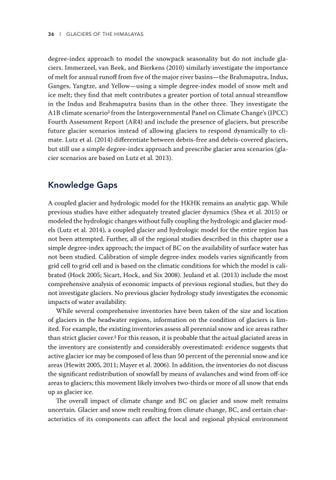36 l Glaciers of the Himalayas
degree-index approach to model the snowpack seasonality but do not include glaciers. Immerzeel, van Beek, and Bierkens (2010) similarly investigate the importance of melt for annual runoff from five of the major river basins—the Brahmaputra, Indus, Ganges, Yangtze, and Yellow—using a simple degree-index model of snow melt and ice melt; they find that melt contributes a greater portion of total annual streamflow in the Indus and Brahmaputra basins than in the other three. They investigate the A1B climate scenario3 from the Intergovernmental Panel on Climate Change’s (IPCC) Fourth Assessment Report (AR4) and include the presence of glaciers, but prescribe future glacier scenarios instead of allowing glaciers to respond dynamically to climate. Lutz et al. (2014) differentiate between debris-free and debris-covered glaciers, but still use a simple degree-index approach and prescribe glacier area scenarios (glacier scenarios are based on Lutz et al. 2013).
Knowledge Gaps A coupled glacier and hydrologic model for the HKHK remains an analytic gap. While previous studies have either adequately treated glacier dynamics (Shea et al. 2015) or modeled the hydrologic changes without fully coupling the hydrologic and glacier models (Lutz et al. 2014), a coupled glacier and hydrologic model for the entire region has not been attempted. Further, all of the regional studies described in this chapter use a simple degree-index approach; the impact of BC on the availability of surface water has not been studied. Calibration of simple degree-index models varies significantly from grid cell to grid cell and is based on the climatic conditions for which the model is calibrated (Hock 2005; Sicart, Hock, and Six 2008). Jeuland et al. (2013) include the most comprehensive analysis of economic impacts of previous regional studies, but they do not investigate glaciers. No previous glacier hydrology study investigates the economic impacts of water availability. While several comprehensive inventories have been taken of the size and location of glaciers in the headwater regions, information on the condition of glaciers is limited. For example, the existing inventories assess all perennial snow and ice areas rather than strict glacier cover.4 For this reason, it is probable that the actual glaciated areas in the inventory are consistently and considerably overestimated: evidence suggests that active glacier ice may be composed of less than 50 percent of the perennial snow and ice areas (Hewitt 2005, 2011; Mayer et al. 2006). In addition, the inventories do not discuss the significant redistribution of snowfall by means of avalanches and wind from off-ice areas to glaciers; this movement likely involves two-thirds or more of all snow that ends up as glacier ice. The overall impact of climate change and BC on glacier and snow melt remains uncertain. Glacier and snow melt resulting from climate change, BC, and certain characteristics of its components can affect the local and regional physical environment




